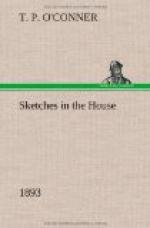At last the division is nearing its close, and the excitement—perhaps, because it is so painfully repressed—has grown until it has almost become unbearable. Whenever there is a close division like this, several things happen which never happen on other occasions. Members gather round the doors of the division lobbies, listening to the tellers as they count one, two, three, four, and so on, in the mechanical voice of the croupiers, bidding the gamblers to play with the dice of death. The Whips also are narrowly watched to see which return first to the House, for the first return means which lobby has been sooner exhausted, and the lobby sooner exhausted is necessarily the smaller lobby, and, therefore, the lobby of the minority. Mr. Marjoribanks, who has told for the Government at the door of the Tory lobby, has returned to the House first. That’s a good sign. But still, if there be a majority, what is it going to be?—disastrously near defeat, or near enough to moral strength as to mean nothing? A few minutes more have to pass before this fateful question is settled. Mr. Thomas Ellis—light, brisk—walks up the floor to the clerk in front of the table. Then the numbers are whispered to Mr. Gladstone. The winning teller always takes the paper from the clerk. It is Mr. Marjoribanks who receives the paper, and the Government has won. A faint cheer, then an immediate hush; we want to know the exact numbers. Mr. Marjoribanks reads them out—a majority of thirty-one. We have won, and we who support the Ministry, cheer; but our majority has been reduced, so the Opposition burst their throats with defiant answer.
Then, with fatuous folly, the Tories insist on another division. Two Irish members, driving straight from Euston station to the House—John Dillon and Mr. Collery—have meantime been added to the Ministerial ranks. Some of the mutineers have come back, and the majority rises to forty-two.
And so ended the great intrigue of the Liberal malcontents against the Gladstone Government.
[Sidenote: Obstruction rampant.]
The word had gone forth—the Home Rule Bill was not to be allowed to pass the second reading before the Easter recess. The slings and arrows of the Tory press had at last begun to have their effect, and obstruction had now been entered upon thoroughly, fiercely, and shamelessly. The first specimen of it was on the following Thursday night, when Mr. T.W. Russell took advantage of an harangue by Mr. Justice O’Brien—those Irish judges are all shameless political partisans—to move the adjournment of the House. Mr. Morley was in excellent fighting form. T.W. Russell is a man peculiarly well calculated to draw out the belligerent spirit of any man, and the Chief Secretary, though he holds himself well under restraint, has plenty of fire and passion in his veins. He let out at T.W. Russell in splendid style, and the more the Tories yelled, the more determinedly did Mr. Morley




